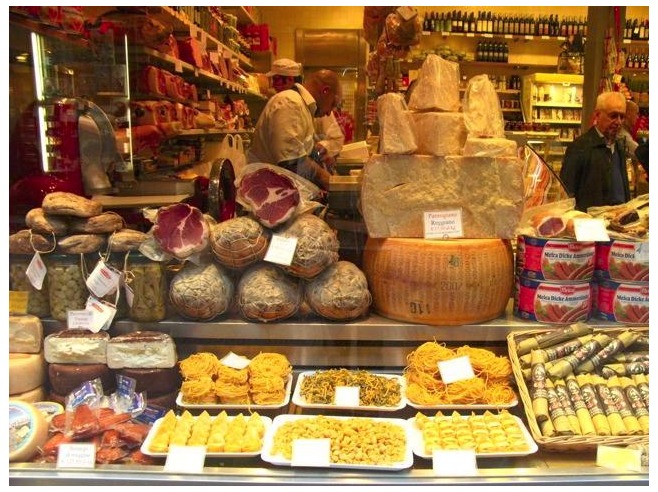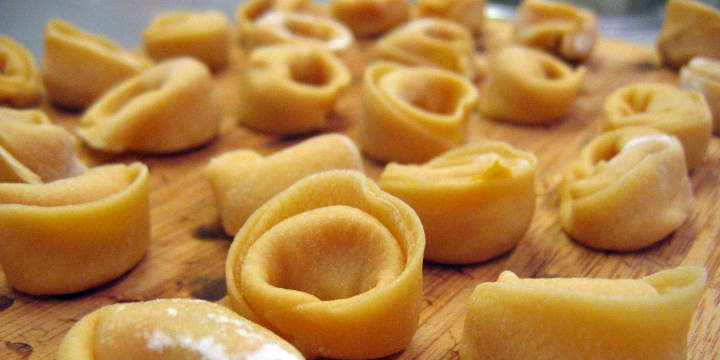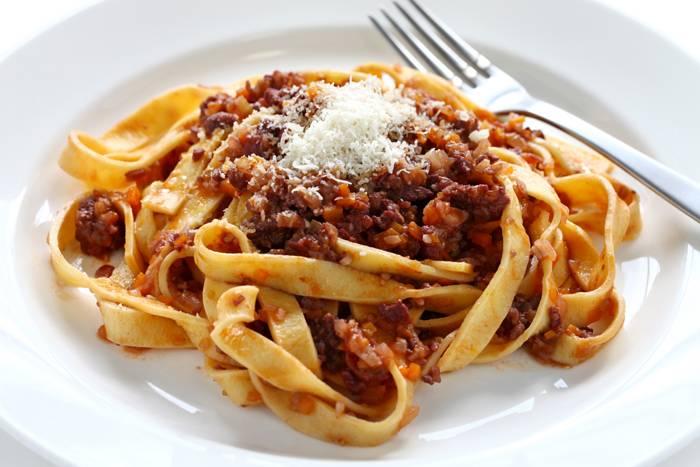Bologna is renowned for its cuisine and for good reasons. This is the hometown of tortellini and mortadella, tagliatelle and ragù, among many other delicacies. Bologna boasts in fact one of the richest culinary traditions in Italy.

To experience this richness, head to the old medieval market and food shopping area, the so-called Quadrilatero, because the little streets are framed within a quadrilateral area by Piazza Maggiore, via Rizzoli, via Castiglione and via Farini. The market has occupied the same area in the city centre since Roman times; its height was during the Middle Ages when, besides the many shops, it was home to the headquarters of many corporations of merchants which had begun to acquire great power with the shift to a new monetary economy. The little streets within the Quadrilatero take their names from the shops and corporations that used to be based there: via Pescherie is where the fishmongers concentrated, via Orefici housed the goldsmiths, via Caprarie was home to the butchers selling sheep and goat meat, via Drapperie was for the upholsterers, and so on. Historic shops where you can taste and buy Bologna’s signature dishes abound.
Start with:
Tortellini

Photo credit Stephen Garrett
Bologna is no doubt synonymous with tortellini! Legend has it that their shape takes inspiration from Venus’ navel. The recipe for authentic tortellini was registered with Bologna’s Chamber of Commerce in 1974, and here it is: the dough is made with flour and eggs, while the filling contains pork loin, Parma ham, mortadella, Parmesan cheese, eggs and nutmeg. One of Bologna’s emblematic figures, the sfogline, are the keepers of the city’s important tradition of hand-made pasta: women who patiently knead and roll the dough so it acquires the right thickness, and, in the case of tortellini, stuff, twist and seal them so they take their characteristic shape and do not break open when you cook them. To enhance their taste, tortellini should be eaten with a broth of capon or hen. It is a typical winter dish that the Bolognesi often cook for their Sunday lunches; it is also part of a traditional Christmas meal.
Where: Tamburini, via Caprarie 1 – an institution in Bologna since the 1930s, it is still managed by the same family that gives the shop its name. It sells an array of Bologna’s specialties; it is particularly renowned for tortellini and mortadella. They also have a self-service area; stop for lunch and try the famous tortellini al ragù. Atti, two locations, via Caprarie 7 and via Drapperie 6 – “luxury bread”, that’s how they label themselves at this 1880 panificio (bakery). The store still has the original furniture. A nice idea for a souvenir or a gift is to buy tortellini or another typical product and put them in the store’s signature liberty box, the same that was used at the beginning of 1900.
Mortadella

As mentioned above, one of the essential ingredients of tortellini is mortadella, another great culinary delicacy hailing from Bologna. It seems that mortadella was already known and thoroughly appreciated by the Romans: proof of this is the mortarum, a utensil that was used to mince pork meat, which you can see inside Bologna’s Museo Civico Archeologico. Further proof is Roman author Plinio, who once described how Emperor Augustus, passing by Bologna, was particularly impressed by this new salume. While today mortadella is considered one of the poor cold cuts, especially when compared to prosciutto or culatello, it used to be a food for the rich and powerful; it was even presented as a wedding gift to noblewoman Lucrezia Borgia when she married Alfonso I, Duke of Este. Mortadella was expensive too, due to the wide use of spices which helped to preserve it longer; it was nine times more expensive than bread, three times more expensive than prosciutto and twice more expensive than olive oil. It is only in the 1800s with the new mechanized production techniques that mortadella became cheaper and available to all.
Where: Tamburini, see above. Salumificio Simoni, via Drapperie 5/2a – it sells artisan mortadella and all other local cold cuts. It also sells Parmigiano Reggiano.
Tagliatelle

The above mentioned Lucrezia Borgia seems to have been the inspiration for another typical Bolognese hand-made pasta, tagliatelle. Legend has it that Mastro Zefirano invented them for her wedding upon seeing her blonde braids. Nice story, however not true. Bologna’s Chamber of Commerce guards the recipe of tagliatelle, along with its measurement rule: tagliatelle should be 8 mm wide when cooked. Their thickness has not been defined, although experts say it should be between 6 and 8 tenth of a millimeter.
Where: Dante Zanetti, via Pescherie Vecchie 6/b – a small bakery selling all types of Bologna hand-made pasta, as well as bread and Bologna’s typical sweets like raviole and torta di riso.
Ragù

And what goes best with tagliatelle if not ragù alla bolognese? The official recipe also rests with Bologna’s Chamber of Commerce since 1982, but with ragù there is a lot of leeway. If you ask people in Bologna, you will find that there are many variations in family recipes and they seem to be very secretive about them. The most important ingredient is minced beef; the tomato based sauce must cook for hours. Ragù goes well with any type of pasta, especially with tagliatelle and lasagne; never ever eat it with spaghetti though - I Bolognesi consider it an insult!
Where: Try to get invited at the home of a Bolognese mom or grandma. No local connections? Get a jar at historic Gilberto, located in via Drapperie 5 since 1905. This grocery store also sells Italian wines, sweets, jams, coffee, honey and balsamic vinegar. There are many more excellent products belonging to Bologna’s rich culinary tradition from tortelli to crescentine, from friggione to the torta degli addobbi; just walk around the area, spot the delicacies on display and let your sensory inspiration guide you.






